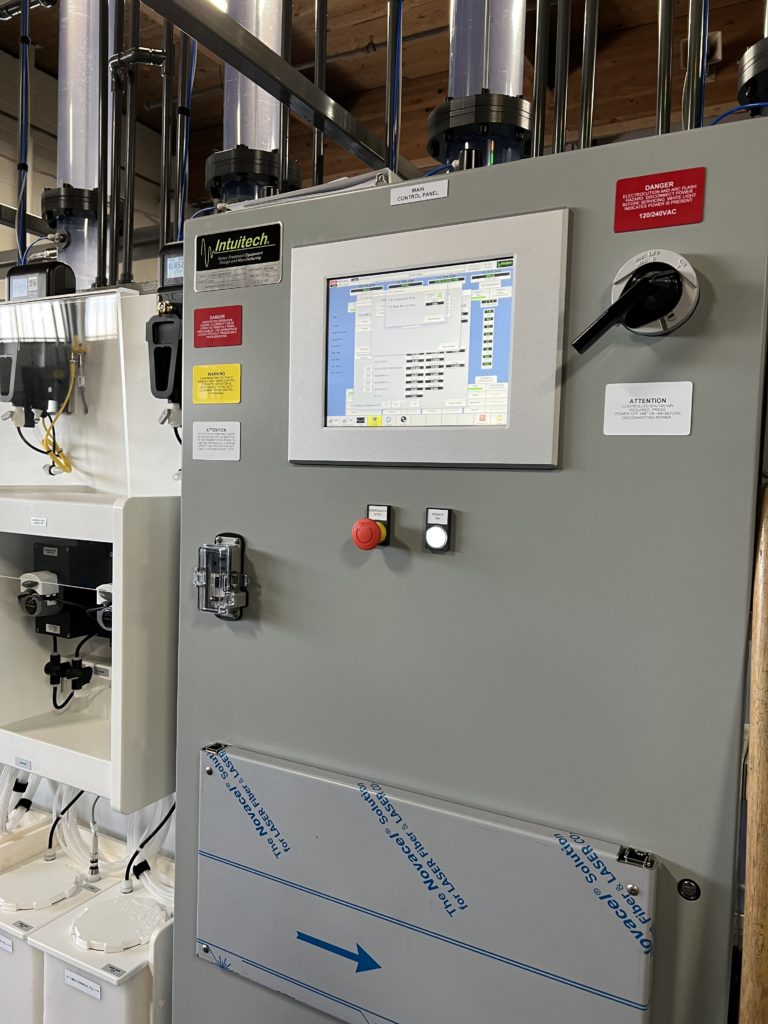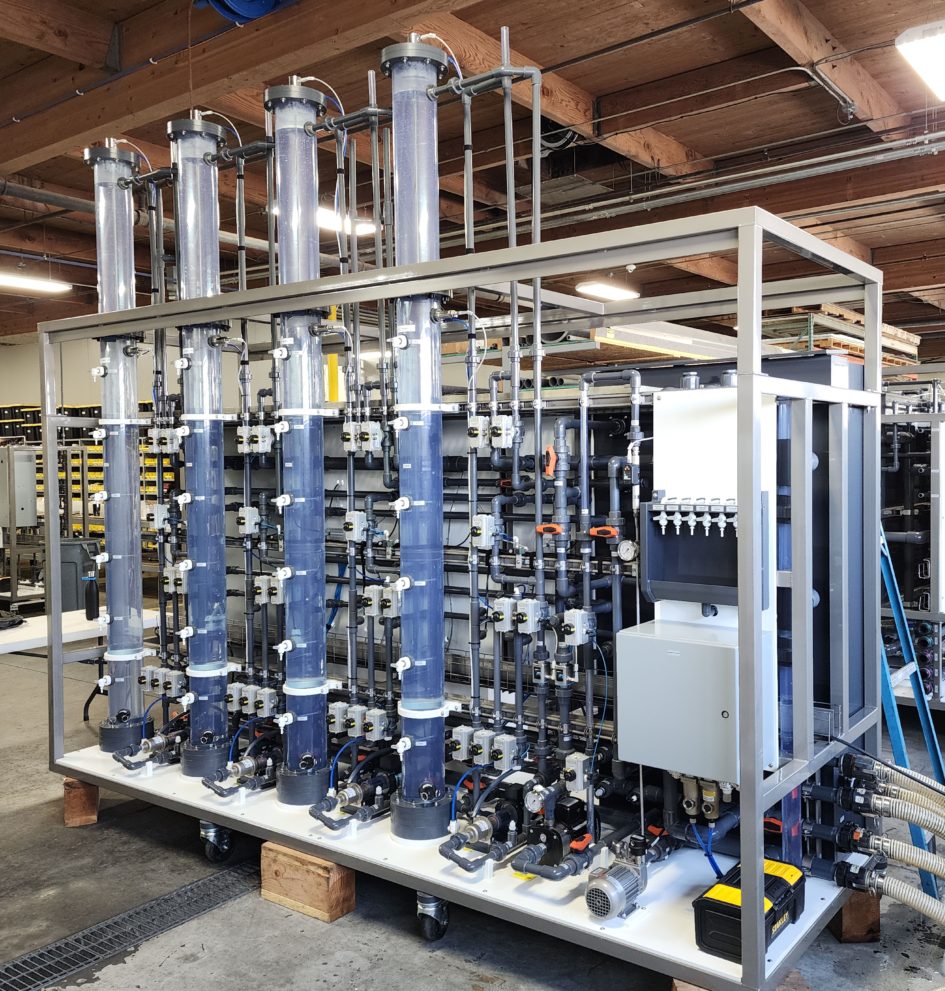Taking a test flight of a treatment method prior to adding a new process or technology is a prudent practice that allows water and wastewater systems to effectively “try before they buy” a change to their system. The State of Utah requires piloting to ensure the effective implementation of future water treatment projects. Even though piloting may not be a requirement in many states, a successful pilot study can provide empirical proof and peace of mind that the methods tested will achieve a water system’s treatment objectives.
“Piloting can help inform design needs for a new facility or treatment process. It can also provide hard evidence that one process is worth investing in rather than another option. The confidence gained by learning a particular treatment is not only feasible, but a good option for a water system, is invaluable,” says Marie Owens, AE2S Client Program Leader.

Compact design of granular media filter pilot system.
Some of the reasons to complete a pilot study include changing a pretreatment process, optimizing corrosion control, testing media types or new processes, optimizing existing treatment, ensuring regulatory requirements can be met, or treating a new water source. Here are three AE2S client experiences with pilot studies that addressed PFAS and pretreatment optimization; biological treatment to address ammonia, iron, and arsenic; and reverse osmosis (RO) membranes for elevated sulfate concentrations.
Woodbury Pilots PFAS Treatment
The State of Minnesota successfully reached a financial settlement with 3M on behalf of the City of Woodbury and other affected communities, following the discovery of per- and polyfluoroalkyl substance (PFAS) contamination in the groundwater in Washington County. AE2S and Jacobs, engineering partners on the Woodbury project, embarked on a two-year pilot study with three phases. The pilot aimed to identify the best treatment technology to remove PFAS using granular activated carbon (GAC) and ion exchange (IX) technologies. Part of the pilot included the evaluation of the benefit of pretreatment on the removal efficiency of these technologies.
The Woodbury study utilized an AE2S pilot skid during the pretreatment phase. As the pilot study concluded, a specific type of GAC was determined to be the optimal treatment method to address PFAS in Woodbury’s wells. Building upon the success of the pilot, in March 2023, Woodbury kicked off a large water treatment infrastructure project that will include 10 miles of raw and three miles of finished watermain, as well as a new 32 million gallon per day (mgd) centralized treatment facility. The water treatment plant will include PFAS treatment with 48 pressure vessels, a four-million-gallon reservoir, 46 mgd pump station, and adequate space to incorporate lime softening in the future. The entire project is scheduled for completion in 2028, ensuring long-term water safety and quality for Woodbury residents.
Lake Lillian Pilots Biological Treatment
Piloting led a small community water system to become one of the first in Minnesota to utilize full scale biological treatment. The Lake Lillian Water Treatment Plant (WTP) provides drinking water to a population of approximately 200 people.
In 2021, the City of Lake Lillian began a pilot project due to periodic taste and order complaints. Biological treatment was piloted to address high levels of ammonia, iron, and arsenic in the raw water sourced from wells near the WTP. Biological treatment uses naturally occurring microorganisms to treat water through oxidation and nitrification. The pilot demonstrated more than 95% of the raw water ammonia could be removed, while simultaneously meeting treatment objectives for iron and arsenic.
“The benefits of biological treatment often include a reduction on chemical costs, primarily for chlorine and permanganate,” explains Ben Julson, AE2S Project Manager.
Following the success of the pilot study, the team of Bollig Engineering and AE2S began designing a new WTP for Lake Lillian with plans to apply biological treatment full scale. Construction is expected to begin in midsummer 2023 on the first phase of the new plant, with substantial completion expected in fall of 2024.
Fargo Pilots Membrane Treatment & Pretreatment Optimization
An increasing number of water systems are choosing to pilot before constructing a full-scale project, even in states where piloting is not required. In North Dakota, the City of Fargo needed to effectively remove elevated sulfates from one of its surface water sources, the Sheyenne River. Due to dramatic seasonal variations in water quality of the source water, it was determined that a pilot study to demonstrate the performance of reverse osmosis (RO) technology should be conducted over an entire year to investigate both cold and warm seasonal impacts. The project team of AE2S and Black & Veatch advocated a prolonged period of study of the critical seasonal characteristics of the Sheyenne River water quality, particularly during spring runoff.
Since membrane applications are highly site specific, the pilot study was crucial to verify the feasibility of the membrane technology, as well as to establish key design parameters. The membrane pilot proved valuable as one RO membrane element, a top performer in other parts of the country, could not be cleaned adequately after exposure to the unique water quality conditions of the Sheyenne River. Without product testing through the pilot study, the City of Fargo potentially could have spent millions of dollars on RO membrane elements that were not the best option for the local water conditions. The RO pilot study also verified that a robust and consistent pretreatment process is critical to membrane performance.
An extensive pretreatment optimization evaluation was also performed during the pilot study, which provided the City of Fargo with a matrix to determine the most cost-efficient way to operate the pretreatment processes in the future to best meet its treatment objectives.
The one-year pilot study proved that RO technology is feasible to reduce sulfate concentrations to acceptable levels in Fargo’s finished water, and the results of the study were incorporated into the Fargo WTP expansion project, which was completed in 2017.
Should Your System Take a Test Flight?

Online monitoring with remote access capability.
If your water system faces challenges such as emerging contaminants, taste and odor issues, water quality, or disinfection byproduct control, a pilot study can operate like a flight simulator for your facility, enabling you to test alternative process efficacy, evaluate alternative chemicals, and optimize your treatment strategy.
“There is a wide variety of pilot study applications for systems that want to demonstrate treatment performance, enhance water quality, and identify cost-effective solutions while minimizing risk,” says Aaron Vollmer, AE2S Client Program Leader.
Launching a pilot study often presents challenges, with one major hurdle being the difficulty of renting pilot skids. Fortunately, AE2S has strategically positioned a pilot skid in the Minneapolis area and two additional units in Utah. The skids in Utah offer the flexibility to be shipped to distant locations as needed. “There’s typically a wait time of months or years to lease a skid, but now that we have three on hand, AE2S can provide more timely support to municipal water suppliers,” says Vollmer.
Contact Nate Weisenburger, AE2S Drinking Water Practice Leader, for more information about piloting.

